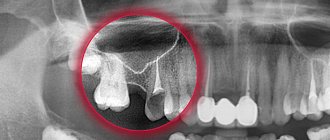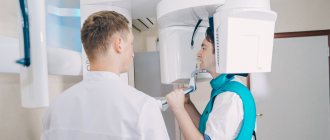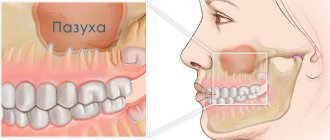What is sinusitis?
Sinusitis is an inflammation of the maxillary sinuses. It usually develops as a complication of a runny nose. The most characteristic signs:
- temperature rises to 37 - 37.5 C;
- nose is stuffed;
- yellow-green nasal discharge appears;
- the bridge of the nose, cheeks near the wings of the nose and temples hurt;
- headache worsens in the evening;
- the sense of smell disappears;
- the voice becomes nasal;
- feeling of general weakness.
When the maxillary sinuses are inflamed, a person quickly gets tired, it is difficult for him to concentrate, and his memory weakens. It is very difficult to work with sinusitis, so it is better to take sick leave.
Sinusitis can be acute or chronic.
I needed to take care of my teeth!
The cause of the disease can be not only a poorly placed filling. Odontogenic sinusitis can also occur due to individual structural features of the upper jaw. But in the vast majority of cases, the disease is caused by improper dental care. For example, a patient starts caries, and necrotic decay of the pulp (dental nerve) begins. The products of necrosis cause inflammation in the perihilar tissues, which then develops through the membrane of the maxillary sinus.
Article on the topic
Expert advice: How to prevent sinusitis?
If, due to a long-term inflammatory process of the upper “sixes”, the tooth has to be removed, an additional problem may arise – a fistula. Then the only solution is surgery: a flap is cut out from the side of the oral cavity, which is used to cover the tooth socket. If the infection has managed to lead to the development of sinusitis, then it is necessary to operate on the maxillary sinus.
However, sometimes the tooth can still be saved. In such cases, the doctor carefully moves the gum with special instruments, cuts out a piece of the root, filling the void with artificial bone tissue and treating the surgical site with medications. Naturally, therapy is simultaneously prescribed for the mucous membrane of the maxillary sinus - this is the prerogative of the otolaryngologist. But it should be noted that healing is a fairly long process, at least a month to a month and a half.
Causes of sinusitis
The disease occurs more often in the cold season in people with weakened immune systems, but this is not the only reason. Inflammation of the maxillary sinus can develop due to:
- complications of a runny nose;
- curvature of the nasal septum;
- damage to the nasopharynx;
- adenoiditis;
- infections and bacteria;
- allergies;
- too dry indoor air;
- work in hazardous industries;
- poor condition of the upper teeth;
- trauma to the mucous membrane of the maxillary sinus.
How does dental sinusitis develop?
The paranasal sinuses (sinus paranasales) consist of a system of several cavities in the near-nasal space.
In the case of a cold, less ventilated sinuses are especially susceptible to developing sinusitis. The maxillary sinuses (sinus maxillaris, maxillary) are relatively well ventilated. However, the floor of the maxillary sinus is separated only by a narrow bony plate from the molars of the upper jaw. Due to this anatomy, the development of dental (odontogenic) sinusitis is quite common. The main cause of odontogenic sinusitis may be inflammation that forms in the area of the roots of the teeth and easily spreads to the mucous membrane of the maxillary sinus. Common pathogens include bacteria such as:
- Streptococcus pneumonia - streptococcus;
- Haemophilus influenza – hemophilus influenzae;
- Moraxella catarrhalis is a protobacterium of Moraxella.
Odontogenic maxillary sinusitis can also form due to tooth extraction (extraction). If one of the maxillary molars is removed, with damage to the bone grafting of the upper jaw, bacteria from the oral cavity can enter the sinus. In this case, they talk about the formation of an unnatural connection between the oral cavity and the paranasal sinus - an oroantral fistula. This trigger factor is considered one of the common causes of “dental” sinusitis.
A third dental cause of sinusitis involves inflamed roots that go unnoticed. As a result, cysts are formed that “grow” into the sinus cavity.
Diagnosis of sinusitis
Treatment of sinusitis will be effective if the patient contacts an ENT specialist in time, the specialist will diagnose and prescribe treatment. The examination includes a number of procedures:
- examination of the nasal cavity;
- palpation or feeling the area around the nose and under the eyes;
- clinical blood test;
- X-ray of the paranasal (paranasal) sinuses - according to indications;
- computed tomography of the sinuses.
X-rays can detect the accumulation of mucus in the sinuses and swelling of the mucous membrane of the sinuses. With sinusitis, a darkening will be visible in the picture, since the mucus and swelling of the tissues in the cavities do not allow x-rays to pass through.
CT scan of the paranasal sinuses is necessary to identify polyps, cysts and anatomical changes. The examination is painless and lasts no more than 5 minutes.
If you feel heaviness when you tilt your head down, and the discomfort subsides some time after you raise your head, contact an ENT specialist. Self-medication with folk remedies, randomly selected antibiotics and nasal drops causes serious complications. Sinusitis can become chronic and cause more severe diseases: otitis media, meningitis, brain abscess, orbital phlegmon (inflammation of the tissue around the eyeball).
Implant into a modified sinus - is it possible?
Some time after tooth extraction, the patient may decide to install an implant. If sinus treatment was not carried out in a timely manner after tooth extraction, it remains to treat sinusitis before sinus lift surgery and implant installation.
It is advisable to do this together with an otolaryngologist.
But at the same time, the patient must understand that during a sinus lift, the altered sinus may rupture because it has an altered structure. And if this does happen, the sinus lift may not take place. Therefore, odontogenic sinusitis still needs to be treated during tooth extraction. And prepare the sinus together with the otolaryngologist.
Treatment of sinusitis
Depending on the patient’s condition and the course of the disease, the doctor prescribes therapy and selects antibacterial, decongestant and anti-inflammatory drugs. Treatment can be conservative or surgical.
Conservative treatment
For mild sinusitis, in addition to drug treatment, according to indications, nasal cavity lavage according to Proetz, or “cuckoo”, is performed. A special solution is injected into the nose of the patient lying on his back. It passes through the nasal cavity, sinuses, after which it is pumped out with a vacuum pump. “Cuckoo” is carried out in a course of 2 to 10 procedures.
For moderate and severe cases of the disease, antibiotics are prescribed in the form of tablets, solution for injection or inhalation.
Surgical treatment (puncture of the maxillary sinus)
In case of severe purulent sinusitis or lack of effect from conservative therapy, a puncture is used. This allows you to quickly remove pus from the sinus, clean it and treat it with an anti-inflammatory drug. Sometimes several similar manipulations are required. Punctures are performed under local anesthesia.
When sinusitis cannot be treated or is in an advanced stage, surgery is performed under general anesthesia. The period of complete recovery after surgery can take up to two weeks.
Sinusitis or tooth – what to treat first?
In this case, many otolaryngologists prescribe tooth extraction.
In our clinic, we collaborate with specialists who treat odontogenic sinusitis or help the patient prepare the sinus mucosa for sinus lifting.
Of course, it is not always possible to prosthetize and treat a tooth with a source of infection in the periodontium in the upper jaw. Therefore, such teeth often still need to be removed.
Tooth extraction surgery is a major source of irritation for the body and the immune system. After it, you need to wait 4-6 months until the porous bone tissue of the alveoli is restored.
In this case, conservative anti-inflammatory therapy, antibiotics, and active copious rinsing of the nasal sinuses are prescribed. Treatment lasts about a month after tooth extraction.
If CT and diagnostics revealed a source of infection (cyst or granuloma) on the tooth, then treatment for odontogenic chronic sinusitis begins immediately after removal. Then the chance to reduce inflammatory changes in the mucosa is quite high.
Otherwise, the patient risks getting large growths, which sometimes occupy more than half the height of the sinus.
This is manifested by nasal congestion, because when we have ARVI, the nasal mucosa swells greatly. And our nasal mucosa is exactly the same as in the sinus: the same columnar epithelium. It swells very much when initially, as a result of constant irritation, the infection has already grown by more than half.
In this case, the half of the nose that is more blocked will be an indicator to check what is wrong with the teeth on the same half of the jaw.
Prevention of sinusitis
To avoid sinusitis you should:
- spend enough time outdoors;
- strengthen immunity;
- Healthy food;
- take vitamins;
- dress according to the weather;
- seek medical help in a timely manner.
If you have discovered the first symptoms of sinusitis and are looking for a qualified specialist who will diagnose and help you cope with the disease, call the phone number listed on the website or leave a request in the feedback form. Medical staff will answer your questions and conduct all necessary examinations within one business day. Let's take care of your health together!
Toothache during a cold: causes and treatment
One of the symptoms of a common cold, along with high fever, runny nose and cough, can be toothache. Teeth that are completely healthy at first glance can turn out to be a source of pain and signal problems with the body. When a toothache occurs due to a cold, adequate treatment prescribed by a general practitioner can quickly relieve you of this unpleasant symptom.
Why does toothache occur with a cold?
Toothache, along with headache and earache, can be a symptom of a cold. It occurs most often due to such a phenomenon as the occurrence of excess pressure in the nasal sinuses. When you have a cold, your sinuses become inflamed, and the mucus that forms in them blocks the passage, creating pressure that leads to pain. As soon as the inflammation of the mucous membrane is relieved, the teeth stop hurting. In addition, when we have a cold, we often drink a lot of liquids that contain acid. It can have a harmful effect on tooth enamel and cause pain. Also, when we have a runny nose, the mucous membrane of our mouth dries out quite noticeably, and the sugar that lingers on it in this way can also negatively affect the teeth.
Toothache due to a cold: treatment
So, we have looked at the main reasons why toothache most often occurs during a cold. Treatment prescribed by a therapist will help you recover as quickly as possible, and therefore get rid of painful sensations in your mouth. In the meantime, while the healing process is underway, you can relieve toothache using one of the proven home remedies.
- Rinsing with a baking soda solution (1 small spoon per glass of warm water) will help relieve inflammation and reduce irritation in the mouth. To achieve maximum effect, it is best to rinse your mouth 2-3 times an hour until signs of improvement appear.
- Dental drops. They can be purchased at any pharmacy for a small price. These drops have a calming effect and are based on camphor and valerian. It is enough to apply a few drops on a cotton swab and apply to the aching area.
- Sage decoction. Keep the warm sage decoction in your mouth for a few minutes, and you will notice that your toothache will become much less intense.
- Painkillers. If toothache causes you a lot of problems during a cold, then you can use any of the painkillers: ibuprofen, paracetamol, etc. The main thing is that the benefits of their use outweigh the harm they can cause to your liver and the entire body as a whole.
You can get a consultation at the DENTISTRY clinic. Make an appointment by calling +7 (8342) 308–088 or using the form below.
Make an appointment
Causes of drug-induced rhinitis
Infectious or allergic rhinitis is manifested by inflammatory reactions, one of the symptoms of which is swelling of the nose. The body tries to cope with this process, and blood circulation increases in the nasal passages. As a result, an increase in the size of blood vessels contributes to the development of nasal congestion. Nasal breathing becomes difficult, the sense of smell is lost, the person rushes to get rid of these unpleasant symptoms with the help of decongestants (vasoconstrictor drops - vasoconstrictors).
From vasoconstrictor drops, blood vessels narrow, swelling quickly subsides, breathing through the nose is restored, and the sense of smell is normalized. The therapeutic effect of decongestants lasts 4-12 hours, after this period the lumen of the blood vessels increases again, swelling and congestion of the nasal passages returns. The patient knows how to get rid of the unpleasant condition and again uses vasoconstrictor drops.
If nasal vasoconstrictor drops are used correctly, addiction does not occur. The recommended period of use of the drugs is 3-7 days. Dependence manifests itself if the patient neglects the instructions for use and violates the frequency and duration of therapy. This is due to the fact that tachyphylaxis develops when the body’s response to repeated use of medications decreases. A person uses the same nasal remedies, but the vessels react poorly to them. To achieve a therapeutic effect, decongestants must be instilled more often.
The main active components of the drugs are substances such as nasazoline, oxymetazoline, xylometazoline, phenylephrine. Violation of the frequency and duration of therapy leads to the fact that the own regulation of capillary tone suffers. Up to the complete destruction of reflex regulation. The capillaries get used to narrowing from nasal drops and wait for the arrival of active components from the outside.
The longer a person uses vasoconstrictor drops, the stronger the addiction and the less chance of restoring their own regulation. You can only get rid of addiction to nasal drops with the help of an ENT specialist.
The relationship between nose and head pain
The nose is one of the sections of the respiratory system. It consists of several departments interconnected. If diseases occur on the visible part of the nose, they are easy to diagnose. However, nasal pain can be caused by damage to the internal parts that are located inside the skull. To understand why the nose hurts and radiates to the head, it is worth familiarizing yourself with its structure.
- The outer nose is the visible part. Its shape is formed by cartilage and several bones, as well as facial muscles. This is the first section into which the inhaled air penetrates, so it is initially purified from small particles and microorganisms.
- The nasal cavity is an expansion formed by bones and cartilage. Its posterior part narrows and passes into the nasopharynx.
- Paranasal sinuses (paranasal sinuses) are additional cavities that are located on opposite sides of the nasal cavity. There are anterior and posterior sinuses.
All parts of the nose are covered with mucous membrane. It is continuous, contains nerves and vessels, and connects to the epithelial layer of the oropharynx. The nasal mucosa has a distinctive feature - it contains olfactory receptors, with the help of which the nervous system is able to distinguish odors. In addition, it is the first barrier against viruses and bacteria that enter the body with inhaled air and can cause infectious diseases of the respiratory system.
Diseases that cause nasal congestion and discomfort reduce the supply of oxygen to the lower respiratory system. This causes insufficient nutrition of tissues, especially brain cells. Most colds are accompanied by a headache, which occurs due to respiratory failure. In addition, colds are accompanied by swelling of the mucous membrane, inflammatory processes, and increased formation of exudate.
Surgical methods of treatment:
- Laser bloodless operation (vaporization), in which altered mucous membranes are removed by evaporation.
- Radio wave thermal reduction.
- An ultrasonic waveguide makes it possible to reduce the volume of blood vessels, after which healthy capillaries are formed in their place and nasal breathing is restored.
- Submucosal vasotomy, conchotomy.
Long-term use of vasoconstrictor drugs leads to serious consequences. Addiction will not go away on its own; specialist help is needed. You can get the necessary treatment at the CELT clinic. Here are high-quality diagnostics and effective therapy. Make an appointment with an ENT doctor right now.
Our services
The administration of CELT JSC regularly updates the price list posted on the clinic’s website. However, in order to avoid possible misunderstandings, we ask you to clarify the cost of services by phone: +7
| Service name | Price in rubles |
| Appointment with a surgical doctor (primary, for complex programs) | 3 000 |
| Endoscopic rhinoscopy | 1 500 |
| X-ray of the paranasal sinuses | 2 200 |
All services
Make an appointment through the application or by calling +7 +7 We work every day:
- Monday—Friday: 8.00—20.00
- Saturday: 8.00–18.00
- Sunday is a day off
The nearest metro and MCC stations to the clinic:
- Highway of Enthusiasts or Perovo
- Partisan
- Enthusiast Highway
Driving directions
Complications arising from drug-induced rhinitis
The most common adverse effects of rhinitis medicamentosa are:
- persistent swelling of the nasal passages;
- night snoring;
- lack of smell;
- nasal voice;
- headache;
- frequent sneezing and watery eyes;
- feeling of itching, tingling and burning in the nose;
- tissue atrophy;
- dryness and hyperplasia of the mucous membranes;
- nosebleeds;
- displacement of the nasal septum.
In most cases, doctors manage to rid the patient of drug addiction using conservative methods. Surgery is used when treatment is ineffective.
Treatment of addiction to nasal drops
The first stage is awareness of the problem. It is necessary to accept that an addiction to nasal drops or sprays has formed. Addiction worsens the quality of life and threatens serious complications.
The next step is to seek help from a competent ENT doctor. A specialist will help distinguish medicinal rhinitis from seasonal or allergic rhinitis, decide how serious the complications are, and select adequate treatment to restore nasal breathing. The sooner the patient contacts the doctor, the more successfully vascular function will be restored.
Drug addiction sometimes takes years to form, so you can’t get rid of it in a couple of days. Nasal breathing improves gradually. Medicines, physiotherapy methods and surgical interventions are used. To make you feel better, the doctor prescribes intranasal anti-inflammatory drugs containing synthetic glucocorticosteroids. The drugs improve the condition of the mucous membrane, facilitate the discharge of mucus, and relieve the symptoms of inflammation. The therapy is complemented by physiotherapeutic procedures - laser treatment, medicinal extracts (herbal medicine), the use of ultraviolet irradiation, tube quartz treatment, etc.
Lay down straws
Today it is not difficult to assess the risk of developing odontogenic sinusitis. Formally, this is the result of the close contact of the maxillary sinus with the apices - the tips of the roots of the upper teeth of the chewing group. Therefore, a simple and effective diagnostic tool is a panoramic photograph of the jaw. The doctor will receive up to 90% of the information about her condition. The rest, if necessary, will be given individual photographs of each tooth. Are your teeth in satisfactory condition? Then you can repeat the examination every 2-3 years!
The development of odontogenic sinusitis is always facilitated by weakened immunity. Moreover, the state of the immune system is directly related to dental health. This means that treatment should always begin with sanitation of the oral cavity.
Diagnostic methods
To determine the cause of headaches and nasal congestion, an examination by a doctor is prescribed. First, you should make an appointment with a therapist, and he will refer you to a specialist of a more narrow specialization if necessary. Most colds are easily identified by clinical signs. Doctors may also order the following tests as needed:
- bacterial seeding of biological materials (nasal discharge, blood or others);
- rhinoscopy – examination of the nasal mucosa;
- general and biochemical blood tests;
- allergy tests to determine the type of allergen.
The Clinical Institute of the Brain has all the conditions for a full examination. There is high-quality, modern equipment here, which helps to quickly and accurately assess the overall picture of the disease.










